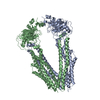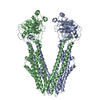+Search query
-Structure paper
| Title | The transport activity of the multidrug ABC transporter BmrA does not require a wide separation of the nucleotide-binding domains. |
|---|---|
| Journal, issue, pages | J Biol Chem, Vol. 300, Issue 1, Page 105546, Year 2024 |
| Publish date | Dec 9, 2023 |
 Authors Authors | Margot Di Cesare / Elise Kaplan / Julia Rendon / Guillaume Gerbaud / Sepideh Valimehr / Alexia Gobet / Thu-Anh Thi Ngo / Vincent Chaptal / Pierre Falson / Marlène Martinho / Pierre Dorlet / Eric Hanssen / Jean-Michel Jault / Cédric Orelle /   |
| PubMed Abstract | ATP-binding cassette (ABC) transporters are ubiquitous membrane proteins responsible for the translocation of a wide diversity of substrates across biological membranes. Some of them confer multidrug ...ATP-binding cassette (ABC) transporters are ubiquitous membrane proteins responsible for the translocation of a wide diversity of substrates across biological membranes. Some of them confer multidrug or antimicrobial resistance to cancer cells and pathogenic microorganisms, respectively. Despite a wealth of structural data gained in the last two decades, the molecular mechanism of these multidrug efflux pumps remains elusive, including the extent of separation between the two nucleotide-binding domains (NBDs) during the transport cycle. Based on recent outward-facing structures of BmrA, a homodimeric multidrug ABC transporter from Bacillus subtilis, we introduced a cysteine mutation near the C-terminal end of the NBDs to analyze the impact of disulfide-bond formation on BmrA function. Interestingly, the presence of the disulfide bond between the NBDs did not prevent the ATPase, nor did it affect the transport of Hoechst 33342 and doxorubicin. Yet, the 7-amino-actinomycin D was less efficiently transported, suggesting that a further opening of the transporter might improve its ability to translocate this larger compound. We solved by cryo-EM the apo structures of the cross-linked mutant and the WT protein. Both structures are highly similar, showing an intermediate opening between their NBDs while their C-terminal extremities remain in close proximity. Distance measurements obtained by electron paramagnetic resonance spectroscopy support the intermediate opening found in these 3D structures. Overall, our data suggest that the NBDs of BmrA function with a tweezers-like mechanism distinct from the related lipid A exporter MsbA. |
 External links External links |  J Biol Chem / J Biol Chem /  PubMed:38072053 / PubMed:38072053 /  PubMed Central PubMed Central |
| Methods | EM (single particle) |
| Resolution | 3.14 - 3.16 Å |
| Structure data | EMDB-16659, PDB-8chb: EMDB-18535, PDB-8qoe: |
| Source |
|
 Keywords Keywords |  MEMBRANE PROTEIN / MEMBRANE PROTEIN /  ABC transporter / drug efflux pump / ABC transporter / drug efflux pump /  homodimer / homodimer /  antibiotic resistance / antibiotic resistance /  TRANSPORT PROTEIN TRANSPORT PROTEIN |
 Movie
Movie Controller
Controller Structure viewers
Structure viewers About Yorodumi Papers
About Yorodumi Papers








